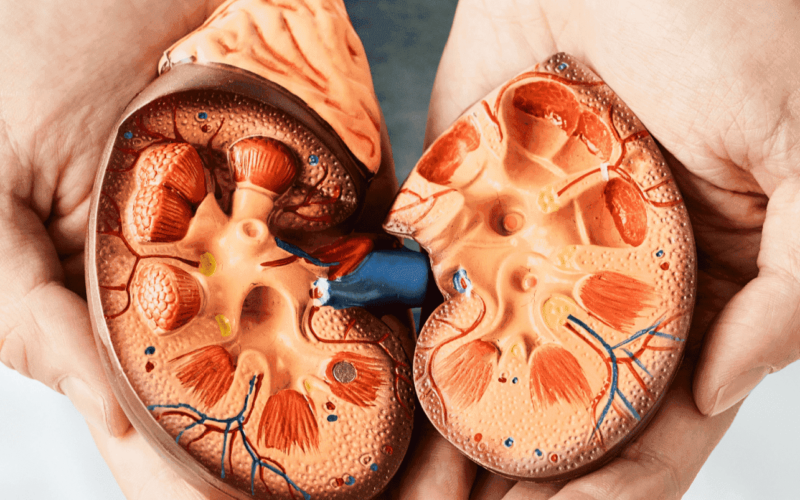Wilms’ tumor, also known as nephroblastoma, is a rare pediatric kidney cancer that primarily affects children under the age of five and arises from immature kidney cells. It may affect one or both the kidneys. The prognosis for Wilms’ tumor is generally promising, with a high survival rate, especially when detected and treated in its early stages. Regular monitoring is essential for long-term care.
What are the causes of Wilms’ Tumor?

The exact cause of Wilms’ tumor is not clearly understood. However, several factors have been associated with an increased risk of developing this condition in children, including:
- Genetic Factors: Some children may have a genetic predisposition to Wilms’ tumor. Specific gene mutations, such as WT1 or WTX and CTNNB1 gene mutations are often linked to Wilms’ tumor.
- Congenital Anomalies: Children born with certain congenital anomalies such as aniridia (absence of the iris in the eye) or hemihypertrophy (asymmetrical growth of body parts), have a higher risk of developing Wilms’ tumor.
- Environmental Factors: Although no specific environmental factors have been definitively linked to Wilm's tumor, some studies suggest that exposure to certain chemicals or toxins during pregnancy may play a role in the development of Wilms’ tumor.
What are the symptoms of Wilms’ Tumor?

Wilms’ tumor often presents with various symptoms, and the severity of these symptoms can vary from one child to another. Common symptoms of Wilms’ tumor include:
- Abdominal swelling or a lump: One of the most noticeable symptoms is a painless swelling or lump in the abdomen.
- Abdominal Pain: Some children may experience abdominal pain or discomfort, which can range from mild to severe.
- Hematuria: Blood in the urine, which can make the urine appear pink, red, or brown, is another common symptom.
- High Blood Pressure: In some cases, Wilms’ tumor can lead to high blood pressure (hypertension).
- Fever: A persistent fever not associated with an obvious infection may be a symptom of Wilms’ tumor.
- Nausea and Vomiting: Some children might experience nausea and vomiting, particularly if the tumor is large and causes pressure on the stomach or other organs.
- Loss of Appetite: Children with Wilms’ tumor may lose their appetite and experience unexplained weight loss.
- Fatigue: Generalized fatigue and weakness can be present due to the tumor's impact on the body.
How is Wilm’s Tumor Diagnosed?

Diagnosing Wilm's tumor typically involves a combination of physical examination, medical history, and various diagnostic tests. These include:
- Physical Examination and Medical History: The healthcare provider will perform a physical examination by taking a detailed medical history. They will ask about the child's symptoms and related family history.
- Blood and Urine Tests: Blood tests are conducted to assess kidney function, while urine tests can reveal the presence of blood or other abnormalities.
- Imaging Studies: Imaging tests, such as ultrasound, CT scans, or MRI, are used to visualize the kidney and the tumor. These tests help determine the size, location, and extent of the Wilms’ tumor.
- Biopsy: In some cases, a biopsy may be performed to obtain a sample of the tumor tissue. This tissue is examined under a microscope to confirm the diagnosis and to determine the specific type and grade of the Wilms’ tumor.
- Staging: Once the diagnosis is confirmed, further tests, such as bone scans and chest X-rays, may be conducted to determine the stage of the tumor. Staging is important in planning the appropriate treatment.
- Genetic Testing: Some children with Wilms’ tumor may undergo genetic testing to check for specific gene mutations associated with the condition.
How is Wilm’s Tumor Treated?

The treatment of Wilms’ tumor typically involves a combination of surgery, chemotherapy, and sometimes radiation therapy. These include:
- Surgery: The primary treatment for Wilms’ tumor is surgical removal of the affected kidney and the tumor. This procedure is called a nephrectomy. In many cases, a partial nephrectomy may be possible if the tumor is small and can be completely removed while preserving as much healthy kidney tissue as possible.
- Chemotherapy: After surgery, chemotherapy is often used to treat any remaining cancer cells and to reduce the risk of recurrence. Chemotherapy drugs are administered through the bloodstream and can target cancer cells throughout the body. The specific chemotherapy regimen may vary based on the child's age and the stage of the tumor.
- Radiation Therapy: Radiation therapy may be considered in some cases, especially if the Wilms’ tumor has a higher risk of recurrence or if there are certain features that suggest a need for radiation treatment. It is recommended in conjunction with surgery and chemotherapy.
- Follow-up Care: After initial treatment, regular follow-up visits with the medical team are essential to monitor any signs of recurrence and to manage any potential long-term effects of the treatment.
To summarize briefly, Wilms’ tumor, a childhood kidney cancer, is typically treated with surgery and often chemotherapy. Prognosis is generally good when diagnosed early, with a high survival rate. Regular follow-up is crucial to monitor potential recurrence. It's important for the child to be treated at a specialized pediatric urological cancer center with expertise in Wilms’ tumor to ensure the best possible outcome.
NU Hospitals in Bangalore, India, are renowned for their expertise in treating children with Wilms’ tumor. They offer advanced pediatric uro-oncology care, experienced pediatric urologists, and state-of-the-art facilities, ensuring comprehensive and effective treatment for young patients with Wilms’ tumor, making them a top choice for pediatric uro-oncology care in India.
References.
Author: Dr. Prasanna Venkatesh M K

